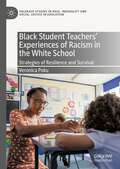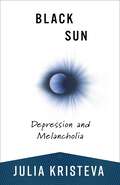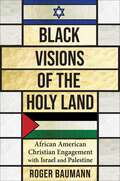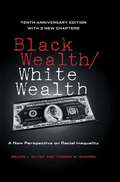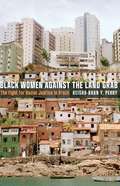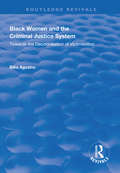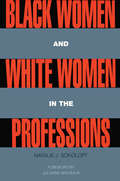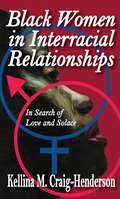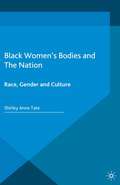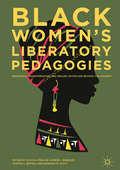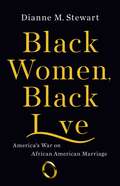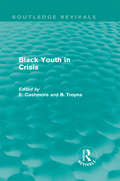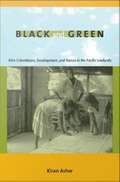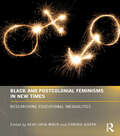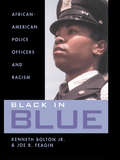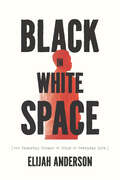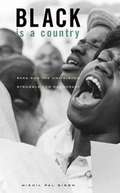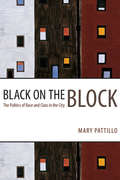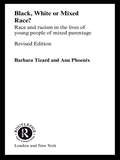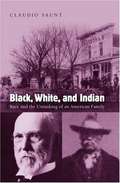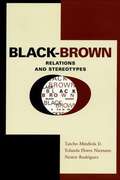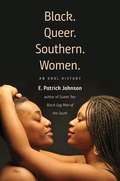- Table View
- List View
Black Sportsmen (Routledge Revivals)
by E. CashmoreFirst published in 1982, Black Sportsmen examines the effect that race has had on sportspeople. The book is based on interviews with a wide range of sportspeople from Olympic athletes to schoolchildren and novices. Written at a time when many black youths were turning to, and succeeding in sports such as athletics, boxing, football, karate and table tennis, this book focuses on the various ways in which black sports competitors reacted to their blackness.
Black Student Teachers' Experiences of Racism in the White School: Strategies of Resilience and Survival (Palgrave Studies in Race, Inequality and Social Justice in Education)
by Veronica PokuThis book investigates the racism experienced by Black teacher trainee Post-graduate students whilst on teaching placements in South London primary schools. Using critical race theory as an epistemological lens, the book goes on to explore their experiences in school via testimonies around the gaslighting they were subjected to. Chapters delve into how these students work to fit themselves into the school’s white space at an emotional and psychological cost and addresses the questions these experiences raise for those in charge of PGCE courses and Initial Teacher Education.
Black Students, Middle Class Teachers
by Jawanza KunjufuA compelling look at the relationship between the majority of African American students and their teachers.
Black Sun: Depression and Melancholia (European Perspectives: A Series in Social Thought and Cultural Criticism)
by Julia KristevaJulia Kristeva examines melancholia across art, literature, philosophy, the history of religion and culture, and psychoanalysis. She describes the depressive as one who perceives the sense of self as a crucial pursuit and a nearly unattainable goal and explains how the love of a lost identity of attachment lies at the very core of depression’s dark heart. Kristeva analyzes Holbein’s controversial 1522 painting The Body of the Dead Christ in the Tomb and considers the works of Marguerite Duras, Dostoyevsky, and Nerval. Black Sun takes the view that depression is a discourse with a language to be learned, rather than strictly a pathology to be treated.
Black Visions of the Holy Land: African American Christian Engagement with Israel and Palestine (Columbia Series on Religion and Politics)
by Roger BaumannSince at least the high point of the civil rights movement, African American Christianity has been widely recognized as a potent force for social change. Most attention to the political significance of Black churches, however, focuses on domestic protest and electoral politics. Yet some Black churches take a deep interest in the global issue of Israel and Palestine. Why would African American Christians get involved—and even take sides—in Palestine and Israel, and what does that reveal about the political significance of “the Black Church” today?This book examines African American Christian involvement in Israel and Palestine to show how competing visions of “the Black Church” are changing through transnational political engagement. Considering cases ranging from African American Christian Zionists to Palestinian solidarity activists, Roger Baumann traces how Black religious politics transcend domestic arenas and enter global spaces. These cases, he argues, illuminate how the meaning of the ostensibly singular and unifying category of “the Black Church”—spanning its history, identity, culture, and mission—is deeply contested at every turn. Black Visions of the Holy Land offers new insights into how Black churches understand their political role and social significance; the ways race, religion, and politics both converge and diverge; and why the meaning of overlapping racial and religious identities shifts when moving from national to global contexts.
Black Wealth / White Wealth: A New Perspective on Racial Inequality
by Melvin Oliver Thomas ShapiroThe award-winning Black Wealth / White Wealth offers a powerful portrait of racial inequality based on an analysis of private wealth. Melvin Oliver and Thomas Shapiro's groundbreaking research analyzes wealth - total assets and debts rather than income alone - to uncover deep and persistent racial inequality in America, and they show how public policies have failed to redress the problem. First published in 1995, Black Wealth / White Wealth is considered a classic exploration of race and inequality. It provided, for the first time, systematic empirical evidence that explained the racial inequality gap between blacks and whites. The Tenth Anniversary edition contains two entirely new and substantive chapters. These chapters look at the continuing issues of wealth and inequality in America and the new policies that have been launched in the past ten years. Some have been progressive while others only recreate inequality - for example the proposal to eliminate the estate tax. Compelling and also informative, Black Wealth / White Wealth is not just pioneering research. It is also a powerful counterpoint to arguments against affirmative action and a direct challenge to current social welfare policies that are tilted towards the wealthy.
Black Women Against the Land Grab: The Fight for Racial Justice in Brazil
by Keisha-Khan Y. Perry<p>In Black Women against the Land Grab, Keisha-Khan Y. Perry describes the key role of local women activists in the citywide movement for land and housing rights. She reveals the importance of geographic location for understanding the gendered aspects of urban renewal and the formation of black women–led social movements. <p>How have black women shaped the politics of urban redevelopment, Perry asks, and what does this kind of political intervention tell us about black women's agency? Her work uncovers the ways in which political labor at the neighborhood level is central to the mass mobilization of black people against institutional racism and for citizenship rights and resources in Brazil.</p>
Black Women and The Criminal Justice System: Towards the Decolonisation of Victimisation (Routledge Revivals)
by Biko AgozinoFirst published in 1997, this book identifies the problems that face black women in the criminal justice system as the result of the articulation of unequal and oppressive class, race and gender relations; the research aims to be aware of all three rather than prioritising, isolating or reducing one or two of these relations. The focus of this research primarily on black women is based on the belief that they are marginalised in both society and criminological research. Black women are poorly represented in education, employment, the professions, commerce, industry and politics while in prison their presence is highly disproportionate to their wider numbers in society. The author examines the problems facing black women and compares these with those facing black men and white women to demonstrate the articulation of social relations. He addresses the structural positions of black women in society, their social relations and the nature of the institutional practices of the criminal justice system.
Black Women and White Women in the Professions: Occupational Segregation by Race and Gender, 1960-1980 (Perspectives on Gender)
by Natalie J. SokoloffFirst published in 1992. Routledge is an imprint of Taylor & Francis, an informa company.
Black Women in Interracial Relationships: In Search of Love and Solace
by Kellina Craig-HendersonAccording to the most recent U.S. census, twice as many black men are involved in interracial relationships as black women. Do black women consciously resist such involvement? What motivates the relatively few women who are in these types of relationships? And how do they navigate the unfamiliar terrain in intimacy?One of the most popular explanations for black women's involvement in interracial intimacy is the unavailability of eligible black men. This explanation focuses on the dismal statistics popularly discussed in reports that forecast lonely futures for African American females. Craig-Henderson explores another, more provocative explanation. She argues that some black women may disassociate from larger social stereotypes by consciously and strategically making choices that distance them from what is considered characteristic of the "typical" African American woman.Scant serious attention has focused upon intimate interracial relationships, perhaps because of a general reluctance to deal with two extremely provocative issues: race and sex. As rates of interracial relationships continue to increase, discussions about interracial intimacy are relevant and timely. Craig-Henderson considers the continuing taboo of interracial relationships involving African Americans, the way this taboo is changing, and the way that contemporary race relations perpetuate longstanding stereotypes about race and sex.The book includes in-depth, unstructured interviews with a wide range of black women currently involved in interracial intimate relationships. Each individual discusses their relationships with family members, beliefs about the influence of race in America, unique problems associated with interracial intimacy, as well as sexual attraction, racial identity, and children. Of particular interest to specialists in race, gender, family, and sexual issues, this work is also accessible and appealing to general readers.
Black Women's Bodies and The Nation: Race, Gender and Culture (Genders and Sexualities in the Social Sciences)
by S. TateBlack Women's Bodies and the Nation develops a decolonial approach to representations of iconic Black women's bodies within popular culture in the US, UK and the Caribbean and the racialization and affective load of muscle, bone, fat and skin through the trope of the subaltern figure of the Sable-Saffron Venus as an 'alter/native- body'.
Black Women's Liberatory Pedagogies: Resistance, Transformation, and Healing Within and Beyond the Academy
by Olivia N. Perlow Durene I. Wheeler Sharon L. Bethea BarBara M. ScottThis interdisciplinary anthology sheds light on the frameworks and lived experiences of Black women educators. Contributors for this anthology submitted works from an array of academic disciplines and learning environments, inviting readers to bear witness to black women faculty's classroom experiences, as well as their pedagogical approaches both inside and outside of the higher education classroom that have fostered transformative teaching-learning environments. Through this multidimensional lens, the editors and contributors view instruction and learning as a political endeavor aimed at changing the way we think about teaching, learning. and praxis.
Black Women, Black Love: America's War on African American Marriage
by Dianne M StewartIn this analysis of social history, examine the complex lineage of America's oppression of Black companionship.According to the 2010 US census, more than seventy percent of Black women in America are unmarried. Black Women, Black Love reveals how four centuries of laws, policies, and customs have created that crisis.Dianne Stewart begins in the colonial era, when slave owners denied Blacks the right to marry, divided families, and, in many cases, raped enslaved women and girls. Later, during Reconstruction and the ensuing decades, violence split up couples again as millions embarked on the Great Migration north, where the welfare system mandated that women remain single in order to receive government support. And no institution has forbidden Black love as effectively as the prison-industrial complex, which removes Black men en masse from the pool of marriageable partners.Prodigiously researched and deeply felt, Black Women, Black Love reveals how white supremacy has systematically broken the heart of Black America, and it proposes strategies for dismantling the structural forces that have plagued Black love and marriage for centuries.
Black Youth in Crisis (Routledge Revivals)
by E. Cashmore and B. TroynaFirst published in 1982, this book considers the position of young Afro-Caribbean people in Britain, in the 1980s. It looks at how, at the time, this group of young people were disproportionately hit by growing unemployment, seemed to be over-represented in crime statistics and were often disadvantage at school. The authors of the book analyse the struggles of the time and look at the reasons for their existence.
Black and Green: Afro-Colombians, Development, and Nature in the Pacific Lowlands
by Kiran AsherIn Black and Green, Kiran Asher provides a powerful framework for reconceptualizing the relationship between neoliberal development and social movements. Moving beyond the notion that development is a hegemonic, homogenizing force that victimizes local communities, Asher argues that development processes and social movements shape each other in uneven and paradoxical ways. She bases her argument on ethnographic analysis of the black social movements that emerged from and interacted with political and economic changes in Colombia's Pacific lowlands, or Choc region, in the 1990s. The Pacific region had yet to be overrun by drug traffickers, guerrillas, and paramilitary forces in the early 1990s. It was better known as the largest area of black culture in the country (90 percent of the region's population is Afro-Colombian) and as a supplier of natural resources, including timber, gold, platinum, and silver. Colombia's Law 70, passed in 1993, promised ethnic and cultural rights, collective land ownership, and socioeconomic development to Afro-Colombian communities. At the same time that various constituencies sought to interpret and implement Law 70, the state was moving ahead with large-scale development initiatives intended to modernize the economically backward coastal lowlands. Meanwhile national and international conservation organizations were attempting to protect the region's rich biodiversity. Asher explores this juxtaposition of black rights, economic development, and conservation--and the tensions it catalyzed. She analyzes the meanings attached to "culture," "nature," and "development" by the Colombian state and Afro-Colombian social movements, including women's groups. In so doing, she shows that the appropriation of development and conservation discourses by the social movements had a paradoxical effect. It legitimized the presence of state, development, and conservation agencies in the Pacific region even as it influenced those agencies' visions and plans.
Black and Postcolonial Feminisms in New Times: Researching Educational Inequalities
by Heidi Safia Mirza Cynthia JosephThis book is a compelling collection of essays on the intersection of race, gender and class in education written by leading black and postcolonial feminists of colour from Asia, Africa and the Caribbean living in Britain, America, Canada, and Australia. It addresses controversial issues such as racism in the media, exclusion in higher education, and critical multiculturalism in schools. Introducing new debates on transglobal female identity and cultures of resistance the book asks: How does black and postcolonial feminisms illuminate race and gender identity in new global times? How are race, gender and class inequalities reproduced and resisted in educational sites? How do women of colour experience race and gender differences in schools and universities? This book is a must for political and social commentators, academic researchers and student audiences interested in new feminist visions for new global times.This book was published as a special issue of Race, Ethnicity and Education.
Black in Blue: African-American Police Officers and Racism
by Joe Feagin Kenneth BoltonFrom New York to Los Angeles, police departments across the country are consistently accused of racism. Although historically white police precincts have been slowly integrating over the past few decades, African-American officers still encounter racism on the job. Bolton and Feagin have interviewed fifty veteran African-American police officers to provide real-life and vivid examples of the difficulties and discrimination these officers face everyday inside and outside the police station from barriers in hiring and getting promoted to lack of trust from citizens and members of black community.
Black in White Space: The Enduring Impact of Color in Everyday Life
by Elijah AndersonFrom the vital voice of Elijah Anderson, Black in White Space sheds fresh light on the dire persistence of racial discrimination in our country. A birder strolling in Central Park. A college student lounging on a university quad. Two men sitting in a coffee shop. Perfectly ordinary actions in ordinary settings—and yet, they sparked jarring and inflammatory responses that involved the police and attracted national media coverage. Why? In essence, Elijah Anderson would argue, because these were Black people existing in white spaces. In Black in White Space, Anderson brings his immense knowledge and ethnography to bear in this timely study of the racial barriers that are still firmly entrenched in our society at every class level. He focuses in on symbolic racism, a new form of racism in America caused by the stubbornly powerful stereotype of the ghetto embedded in the white imagination, which subconsciously connects all Black people with crime and poverty regardless of their social or economic position. White people typically avoid Black space, but Black people are required to navigate the “white space” as a condition of their existence. From Philadelphia street-corner conversations to Anderson’s own morning jogs through a Cape Cod vacation town, he probes a wealth of experiences to shed new light on how symbolic racism makes all Black people uniquely vulnerable to implicit bias in police stops and racial discrimination in our country. An unwavering truthteller in our national conversation on race, Anderson has shared intimate and sharp insights into Black life for decades. Vital and eye-opening, Black in White Space will be a must-read for anyone hoping to understand the lived realities of Black people and the structural underpinnings of racism in America.
Black in White Space: The Enduring Impact of Color in Everyday Life
by Elijah AndersonFrom the vital voice of Elijah Anderson, Black in White Space sheds fresh light on the dire persistence of racial discrimination in our country. A birder strolling in Central Park. A college student lounging on a university quad. Two men sitting in a coffee shop. Perfectly ordinary actions in ordinary settings—and yet, they sparked jarring and inflammatory responses that involved the police and attracted national media coverage. Why? In essence, Elijah Anderson would argue, because these were Black people existing in white spaces. In Black in White Space, Anderson brings his immense knowledge and ethnography to bear in this timely study of the racial barriers that are still firmly entrenched in our society at every class level. He focuses in on symbolic racism, a new form of racism in America caused by the stubbornly powerful stereotype of the ghetto embedded in the white imagination, which subconsciously connects all Black people with crime and poverty regardless of their social or economic position. White people typically avoid Black space, but Black people are required to navigate the “white space” as a condition of their existence. From Philadelphia street-corner conversations to Anderson’s own morning jogs through a Cape Cod vacation town, he probes a wealth of experiences to shed new light on how symbolic racism makes all Black people uniquely vulnerable to implicit bias in police stops and racial discrimination in our country. An unwavering truthteller in our national conversation on race, Anderson has shared intimate and sharp insights into Black life for decades. Vital and eye-opening, Black in White Space will be a must-read for anyone hoping to understand the lived realities of Black people and the structural underpinnings of racism in America.
Black is a Country: Race and the Unfinished Struggle for Democracy
by Nikhil Singh<p>Despite black gains in modern America, the end of racism is not yet in sight. Nikhil Pal Singh asks what happened to the worldly and radical visions of equality that animated black intellectual activists from W. E. B. Du Bois in the 1930s to Martin Luther King, Jr. in the 1960s. In so doing, he constructs an alternative history of civil rights in the twentieth century, a long civil rights era, in which radical hopes and global dreams are recognized as central to the history of black struggle. <p>It is through the words and thought of key black intellectuals, like Du Bois, Ralph Bunche, C. L. R. James, Richard Wright, Ralph Ellison, Langston Hughes, and others, as well as movement activists like Malcolm X and Black Panthers, that vital new ideas emerged and circulated. Their most important achievement was to create and sustain a vibrant, black public sphere broadly critical of U.S. social, political, and civic inequality. <p>Finding racism hidden within the universalizing tones of reform-minded liberalism at home and global democratic imperatives abroad, race radicals alienated many who saw them as dangerous and separatist. Few wanted to hear their message then, or even now, and yet, as Singh argues, their passionate skepticism about the limits of U.S. democracy remains as indispensable to a meaningful reconstruction of racial equality and universal political ideals today as it ever was.</p>
Black on the Block: The Politics of Race and Class in the City
by Mary PattilloThere was a time when North Kenwood-Oakland was plagued by gangs, drugs, violence, and the font of poverty from which they sprang. But in the late 1980s, activists rose up to tackle the social problems that had plagued the area for decades. Black on the Block tells the remarkable story of how these residents laid the groundwork for a revitalized and self-consciously black neighborhood that continues to flourish today. But theirs is not a tale of easy consensus and political unity, and here Pattillo teases out the divergent class interests that have come to define black communities like North Kenwood-Oakland. She explores the often heated battles between haves and have-nots, home owners and apartment dwellers, and newcomers and old-timers as they clash over the social implications of gentrification. Along the way, Pattillo highlights the conflicted but crucial role that middle-class blacks play in transforming such districts as they negotiate between established centers of white economic and political power and the needs of their less fortunate black neighbors. "A century from now, when today's sociologists and journalists are dust and their books are too, those who want to understand what the hell happened to Chicago will be finding the answer in this one. "-- Chicago Reader "To see how diversity creates strange and sometimes awkward bedfellows... turn to Mary Pattillo's Black on the Block."-- Boston Globe
Black, White or Mixed Race?: Race and Racism in the Lives of Young People of Mixed Parentage
by Ann Phoenix Barbara TizardThe number of people in racially mixed relationships has grown steadily over the last thirty years, yet these people often feel stigmatised and unhappy about their identities. The first edition of Black, White or Mixed Race? was a ground-breaking study: this revised edition uses new literature to consider what is now known about racialised identities and changes in the official use of 'mixed' categories. All new developments are placed in a historical framework and in the context of up-to-date literature on mixed parentage in Britain and the USA. Based on research with young people from a range of social backgrounds the book examines their attitudes to black and white people; their identity; their cultural origins; their friendships; their experiences of racism. This was the first study to concentrate on adolescents of black and white parentage and it continues to provide unique insights into their identities. It is a valuable resource for all those concerned with social work and policy.
Black, White, and Indian: Race and the Unmaking of an American family
by Claudio SauntThis book explores the history of a Native American family using a rich collection of sources, including G. W. Grayson's never-before studied forty-four volume diary. <p><p>At the heart of the narrative is a fact suppressed to this day by some Graysons: one branch of the family is of African descent. Focusing on five generations, from 1780 to 1920, this book reveals the terrible compromises that Indians had to make to survive in the shadow of the expanding American republic. Overwhelmed by the racial hierarchy of the United States, American Indians disowned their kin, enslaved their relatives, and fought each other on the battlefield. In the 18th-century native South, when the Graysons first welcomed Africans into their family, black-Indian relationships were common and bore little social stigma. <p><p>But as American slave plantations began to spread across Indian lands, race took on ever greater significance. Native American families found that their survival depended on distancing themselves from their black relatives. The black and Indian Graysons survived the invasion of the Creek Nation by US troops in 1813 and again in 1836, endured Indian removal and the Trail of Tears, battled each other in the Civil War, and weathered the destruction of the Creek Nation in the 1890s. <p><p>When they finally became American citizens in 1907, Oklahoma law defined some Graysons as white, some as black. By this time, the two sides of the family, divided by race, barely acknowledged each other.
Black-Brown: Relations and Stereotypes
by Mindiola Jr. Tatcho Niemann Yolanda Flores Nestor RodriguezOffering some of the first in-depth analyses of how African Americans and Hispanics perceive and interact with each other, this pathfinding study looks at black-brown relations in Houston, Texas, one of the largest U.S. cities with a majority ethnic population and one in which Hispanics outnumber African Americans. Drawing on the results of several sociological studies, the authors focus on four key issues: how each group forms and maintains stereotypes of the other, areas in which the two groups conflict and disagree, the crucial role of women in shaping their communities' racial attitudes, and areas in which Hispanics and African Americans agree and can cooperate to achieve greater political power and social justice.
Black. Queer. Southern. Women: An Oral History
by E. Patrick JohnsonDrawn from the life narratives of more than seventy African American queer women who were born, raised, and continue to reside in the American South, this book powerfully reveals the way these women experience and express racial, sexual, gender, and class identities--all linked by a place where such identities have generally placed them on the margins of society. Using methods of oral history and performance ethnography, E. Patrick Johnson's work vividly enriches the historical record of racialized sexual minorities in the South and brings to light the realities of the region's thriving black lesbian communities. <P><P> At once transcendent and grounded in place and time, these narratives raise important questions about queer identity formation, community building, and power relations as they are negotiated within the context of southern history. Johnson uses individual stories to reveal the embedded political and cultural ideologies of the self but also of the listener and society as a whole. These breathtakingly rich life histories show afresh how black female sexuality is and always has been an integral part of the patchwork quilt that is southern culture. <P><P>E. Patrick Johnson is the Carlos Montezuma Professor of Performance Studies and African American Studies at Northwestern University and author of Sweet Tea: Black Gay Men of the South.

